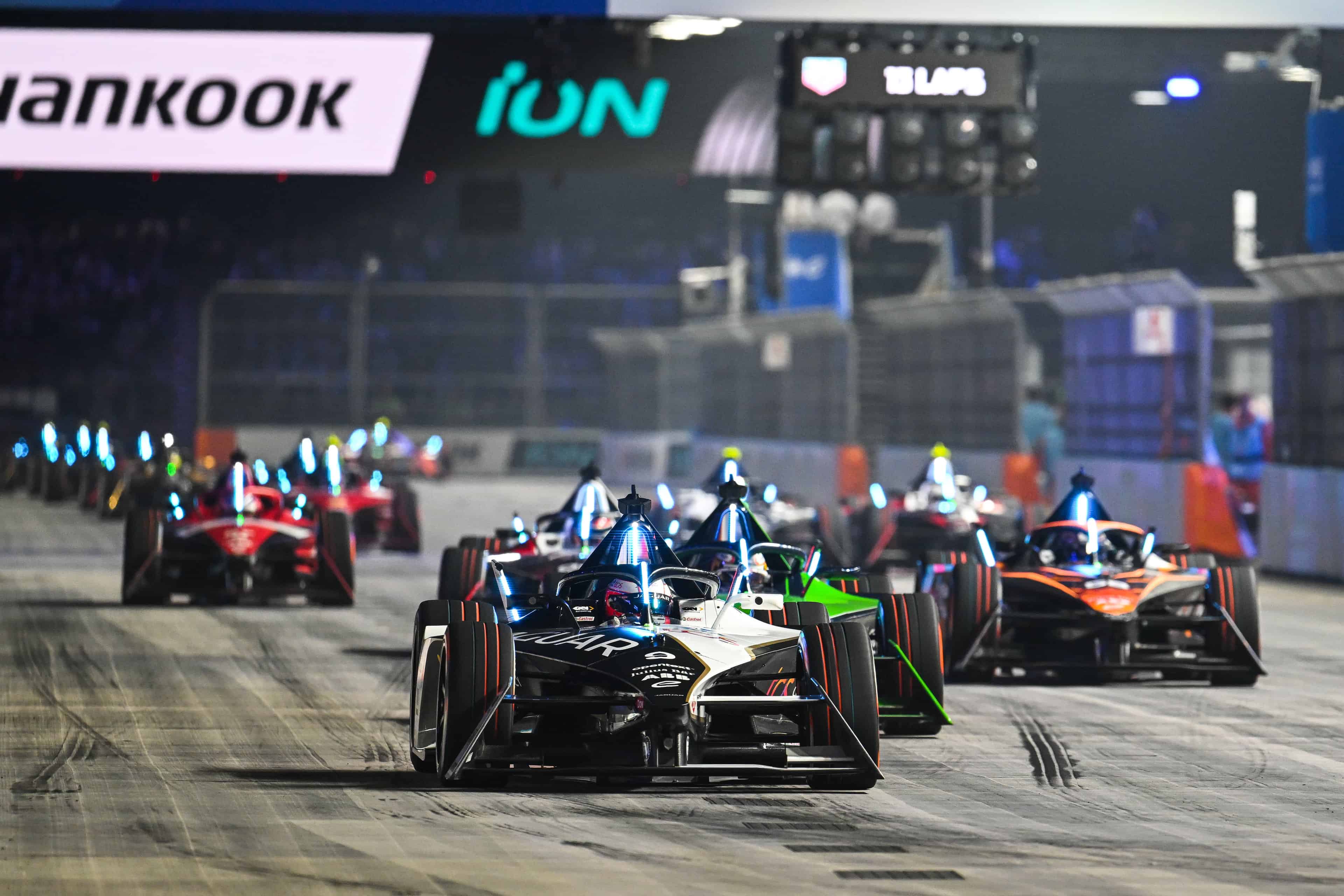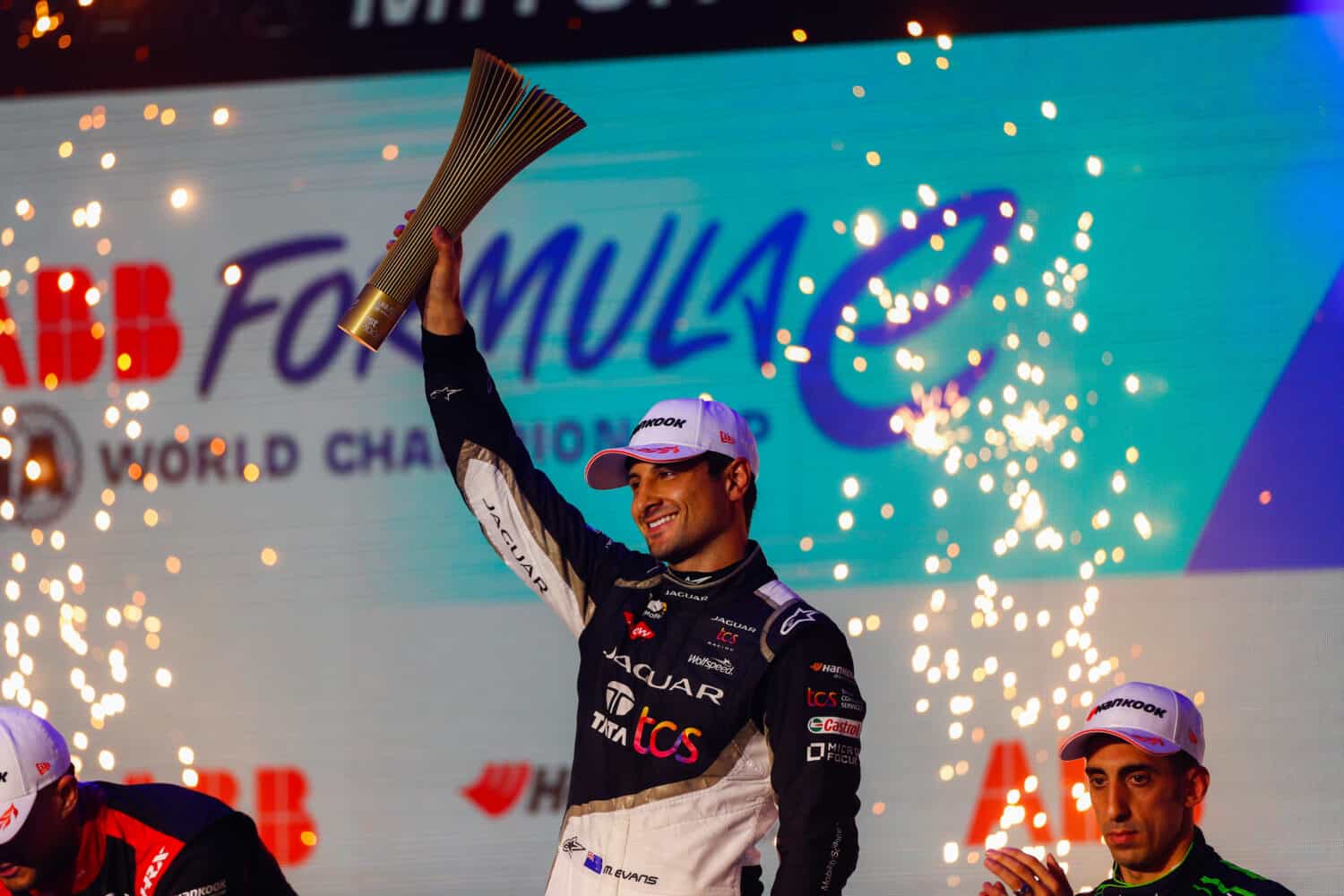During the London E-Prix we were invited to watch the Jaguar TCS Racing. Tata Consulting Services supports the racing team in all digital initiatives, from providing data insights to creating a digital twin. The associated learning process is already leading to innovations in other areas, from electric cars to cosmetics.
Anyone familiar with the world of motorsport knows that Formula E (FE) is in a unique category. Unlike major players such as F1, the World Endurance Championship and NASCAR, racing cars rely entirely on electric propulsion. There, seven engine manufacturers, including Jaguar, compete to produce as much power as possible. Every participating car has the same specs, from mechanical suspension to aerodynamics. Over the past decade, FE has continued to strive to improve this. The well-known Gen3 model made its debut in mid-2022, faster than its predecessors and even more dependent on the regeneration of electricity, for example by converting the energy released by breaking into usable power. In total, about 40 percent of the horsepower produced is based on regeneration, or recaptured energy.
Jaguar and TCS: relatives
As for Formula E, Jaguar and TCS are logical partners. As a car brand, Jaguar Land Rover (JLR) is part of the Tata Group umbrella. In addition, the increasing importance of digital technology in conventional vehicles is another reason to work more closely together. TCS has become the main sponsor from the 2021/22 season. TCS has created a cloud environment for the team to speed up the flow of data between the race track and the team base. Together with Jaguar, they use this data to predict race results and improve performance. That is very important, as there are ten other teams that are very eager to win. Team boss James Barclay sees the game as “a game of chess with 22 players on the field”; data is an important resource in this regard.
Efficiency is especially important in TCS; This is now necessary to develop electric vehicles (EVs) that will replace the old petrol cars, says Varun Kapur, UK and Ireland Head of Manufacturing and Services at TCS. “We are using the data and insights from our partnership with Jaguar TCS Racing to transform the entire EV manufacturing and charging system. These insights have already helped us fine-tune key components in consumer EVs. For example, our TCS manufacturing team works with partners to create and to create new batteries that are lighter, store more energy and charge faster.”
A real example of this level of efficiency is that Jaguar EV I-PACE got 20 extra kilometers. TCS can achieve this by updating the software.
Digital twins
Formula E is not run on regular circuits: the London race takes place in the ExCel exhibition space and is even indoor, with a two-floor layout and twenty corners. This became even more fun when it started to rain: two-thirds of the track was wet while the inside remained dry. The biggest challenge for teams and drivers is that these tracks are only there for a while, with the behavior changing over the years due to, for example, new bumps and slightly different placement of obstacles. In other words, you can’t just rely on an old 3D scanner to try on the simulator. Each team must think about how to prepare for each race: a technology partner is essential for this.
For the team, the race begins months before it takes place physically. Drivers prepare for the next event by completing laps on a simulated track. In any case, the car itself has an almost exact counterpart, but simulating the real world requires more information. Barclay explains how TCS plays an important role in this. “We have a driving-in-the-loop simulator in our Remote Driving Room in Oxfordshire that we use for every race. Before we come here to London, we usually let the drivers drive in it for two days.” The team then uses what they have learned and matches the real-world data to the experimental situation.The better this matches, the more convincing the digital twin is.
The simulator test is an important preparation for drivers, but it is very important to be able to analyze in advance how little energy is used. Only 40 kWh are available per car in each race, which makes it important to figure out how to achieve the fastest times with that energy budget. In the simulator, not only the driver, but also the car can learn how to do it as efficiently as possible. “The brain of the virtual car ‘thinks’ it’s the real car,” says Barclay. TCS contributes to this by keeping all data on a cloud platform. During a race weekend, approximately 3 terabytes of data is collected. This informs what the car’s configuration will be like, including the drivetrain, suspension, power consumption and software. However, it is largely about improvement because the online sessions have already provided a lot of knowledge beforehand.
And to the outside world?
The key word that Barclay uses is “prediction”: all the digital representations of reality together make it possible to say something meaningful about the future. Digital twins can therefore be of great importance not only within Formula E or the racing world. Futurists at TCS believe that this technology will fundamentally change the world by 2035. “Some of the sectors expected to benefit from digital twins include healthcare, retail and sustainability,” says Kapur. “Digital twins of the human body, for example, can help in healthcare to ensure that medical procedures can be carried out earlier and provide personalized treatment. Digital twins of human organs, such as the Heart and Skin BioTwins from TCS, are already they show potential for future treatments.

Another example of digital twinning can be found in the work TCS did with Harvard University and Germany’s LMU. A virtual version of human skin was developed to replace cosmetic testing on animals, which was increasingly restricted. Kapur: “The team came up with a digital twin for human skin based on a concept called ‘multiscale modeling’ which simulates the physiochemical nature of the skin. TCS has already been recognized for developing microscopic models of skin layers for in-silica screening of pharmaceuticals and cosmetic formulations.
Coming back to sports, Kapur also mentions TCS’s participation in the London and New York marathons. In the future, the company wants to bring together all kinds of biological data to create customized training programs for each athlete.

In London
As a team, Jaguar TCS Racing is increasingly competing for prizes. Unfortunately, during the E-Prix it turns out to be impossible to become the champion for the first time. Despite race 1 victory for New Zealander Mitch Evans, he will need a lot of luck to take the championship. Englishman Jake Dennis takes the drivers’ championship, with Jaguar as a team taking second place this season. It’s the same as the constructor’s best achieved position, with enough incentive to win in 2023/24. Fellow New Zealander Nick Cassidy, another title contender who fell short of Dennis, will in any case strengthen the team of James Barclay and Mitch Evans. In doing so, he will no doubt appreciate the role that TCS plays in the Jaguar Formula E team’s success.
Read also: Can an ERP package decide a Formula 1 race?

























